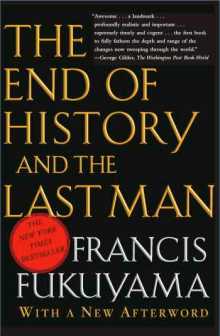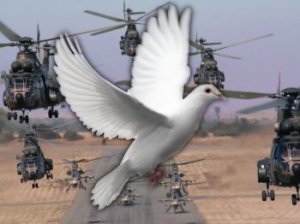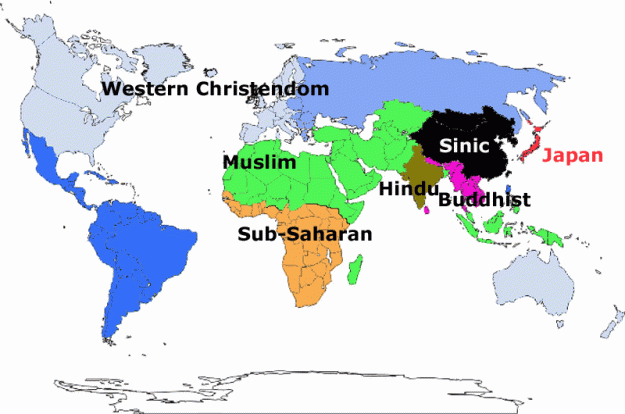By Martin van Creveld
From his website, 19 March 2015
Summary: In today’s post Martin van Creveld, among our time’s top historians and military theorists, looks at the geopolitical state of the world. Are the doomsters right, and it is falling down? Or have we begun a new era of peace with the triumph of western culture around the world?
“A new world order” is in the making, said U.S President George Bush Sr. as the Cold War ended and the Soviet Union, its limbs broken, was lying prostrate. “The end of history” has come, proclaimed famed political scientist Francis Fukuyama. At the core of World War II, Fukuyama explained, stood a titanic struggle between three ideologies: liberal democracy, fascism, and communism. By 1945 fascism had been destroyed. Fifty-something years later, communism too had failed and would not rise again.
But that, Fukuyama continued, was only the beginning. As more and more countries became industrialized and developed a strong middle class, Hollywood and McDonald’s would spread the happy tidings. They would do away with all kinds of cultural relics, globalize the world, and make it safe for liberal democracy. Better still: since everybody knew that democracies never, ever fight each other, war itself would gradually disappear. The new world order, Fukuyama wrote, might be a trifle boring. But that seemed a small price to pay for the blessings of peace and, hopefully ever-spreading prosperity as well.
Available at Amazon (1992).
(1992).
 (1992).
(1992). A quarter of a century later, most of our dreams have been shattered. True, fascism and communism in their classical forms have not made a serious comeback. But autocracy, which is almost as bad, continues to govern large parts of the earth’s population. Some autocratically-governed countries, such as Belarus and North Korea, have done badly. One, Russia, is currently fighting what may be seen either as a war of expansion or as a desperate struggle to assert itself and avoid disintegration. And at least one, China, has done spectacularly well.
A quarter of a century later, most of our dreams have been shattered. True, fascism and communism in their classical forms have not made a serious comeback. But autocracy, which is almost as bad, continues to govern large parts of the earth’s population. Some autocratically-governed countries, such as Belarus and North Korea, have done badly. One, Russia, is currently fighting what may be seen either as a war of expansion or as a desperate struggle to assert itself and avoid disintegration. And at least one, China, has done spectacularly well.
As a Chinese friend told me, this is the first period in Chinese history when almost everybody has enough to eat. In a country as large, and over long periods as poor as China used to be, that is no mean achievement. And as a Nigerian student told me: When the Chinese come marching into a “developing” country they do not waste their time preaching democracy and human rights as Westerners always do. Instead they bring dollars, lots and lots of them. Nor are they shy of paying bribes where they think doing so will grease the wheels. The outcome is that, in quite some places, Chinese autocracy, far from being denounced for its lack of democracy and freedom, is praised as a model to follow.
Another widespread belief which did not come true was that wealth, generated by new technologies and better, read less coercive, methods of organization, would keep spreading. It is not that the world has become poorer. Rather what has happened is that the distribution of wealth has changed. As the French economist Thomas Picketty in his book, Capital in the Twenty-First Century, has shown, not since the early years of the twentieth century has the gap between rich and poor been as large as it is at present.
The world has not become less diverse. In 1993, just four years after “The End of History,” the late Professor Samuel Huntington came out with “The Clash of Civilizations“. In it he argued that Fukuyama had been wrong. What rules the world is not ideology but identity. Shaped by “history, language, culture, tradition, and, most important, religion,” different identities make themselves manifest in the form of “different views on the relations between God and man, the individual and the group, the citizen and the state, parents and children, husband and wife, as well as differing views of the relative importance of rights and responsibilities, liberty and authority, equality and hierarchy.” “These differences,” Huntington concluded, “are the product of centuries. They will not soon disappear.”
Over the last quarter century struggles over just such identities have become the leading cause of armed conflict. Pace Fukuyama and many others, notably the American psychology professor Steve Pinker in The Better Angels of Our Nature (2014), the world has not become more peaceful. To the contrary: it has witnessed any number of ferocious armed conflicts in places as far apart as the former Yugoslavia, parts of Africa and Asia, the Middle East, and, most recently, the Ukraine. In all these wars far more civilians than combatants were killed. The total number of victims, men, women and children, runs into the millions.
So bad have some of these conflicts been that some of the states in which they were waged, far from advancing towards prosperity and liberal democracy, have simply collapsed. That includes Afghanistan, the Central African Republic, the Congo, Somalia, Iraq, Libya, South Sudan, Sudan, Syria and Yemen. Several others, such as Chad, Nigeria, and Pakistan have been left almost equally government-less and may turn belly up at any moment. Supposing immigration, and the problems it creates, is allowed to continue unchecked, even Western Europe may not be immune forever.
The widespread incidence of war, and the even more widespread incidence of preparation for it, explains why military spending did not enter a slow, steady decline as many people during the early 1990s expected to happen. According to figures provided by the Stockholm International Peace Research Institute, “spending in 2012 was… higher in real terms than the peak near the end of the cold war.” In fact it was only in Europe that spending went down at all. By contrast, Russia, North Africa, the Middle East, East Asia, and South Asia have all seen sharp increases. So, between 2001 and the “end” of the wars in Iraq and Afghanistan, did the U.S.A development that will bring the trend to an end does not appear anywhere in sight.
 Briefly, the world is in a mess. But is the mess really worse than it used to be? Worse, for example, than it was between 1914 and 1945? Worse than it was throughout the Cold War, when each Superpower had tens of thousands of nuclear weapons ready for immediate delivery and a nuclear holocaust sometimes seemed to be just around the corner? Worse than it was in 1945-75 when the various Wars in Indochina, the War in Algeria, and civil war in Nigeria, to list but a few, killed millions? Worse than it was in 1958-76, when first the Great Leap Forward and then the Cultural Revolution killed an estimated 45 million Chinese? Worse than in the 1980s, when Iran and Iraq used poison gas against one another? Worse than in the 1990s, when the civil wars in Angola, Mozambique and Sri Lanka were still raging?
Briefly, the world is in a mess. But is the mess really worse than it used to be? Worse, for example, than it was between 1914 and 1945? Worse than it was throughout the Cold War, when each Superpower had tens of thousands of nuclear weapons ready for immediate delivery and a nuclear holocaust sometimes seemed to be just around the corner? Worse than it was in 1945-75 when the various Wars in Indochina, the War in Algeria, and civil war in Nigeria, to list but a few, killed millions? Worse than it was in 1958-76, when first the Great Leap Forward and then the Cultural Revolution killed an estimated 45 million Chinese? Worse than in the 1980s, when Iran and Iraq used poison gas against one another? Worse than in the 1990s, when the civil wars in Angola, Mozambique and Sri Lanka were still raging?
Whenever the mess was particularly great many people thought the world was coming to an end. But it did not. To deny the widespread existence of war, death, horror and hunger would be both foolish and counterproductive. And of course we should do everything in our power to prevent them as far as we can. Yet on the edge of many raging conflicts, often even in the eye of the storm, plenty of decency, generosity, altruism, and, last not least, love have always sprouted. Certainly no less so than in any previous age.
By one story I read long ago, people once asked Mao Tze Dong whether, following a nuclear war, there would still be a world left. To this he is supposed to have answered as follows:
The sun will keep rising
Trees will keep growing
and women
will keep having children.

No comments:
Post a Comment